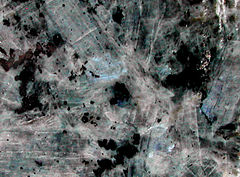Labradorite
| Labradorite | |
 Labradorite | |
| General | |
|---|---|
| Category | feldspar, tectosilicate |
| Chemical formula | (Ca,Na)(Al,Si)4O8, whereCa/(Ca + Na) (% Anorthite) is between 50%-70% |
| Identification | |
| Crystal system | triclinic |
| Twinning | common |
| Cleavage | three directions |
| Streak | white |
| Specific gravity | 2.71 to 2.74 |
| Refractive index | 1.555 to 1.575 |
| Other characteristics | iridescence |
Labradorite ((Ca,Na)(Al,Si)4O8), a feldspar mineral, is an intermediate to calcic member of the plagioclase series. It is usually defined as having "%An" (anorthite) between 50 and 70. The specific gravity ranges from 2.71 to 2.74. The streak is white, like most silicates. Therefractive index ranges from 1.555 to 1.575. Twinning is common. As with all plagioclase members the crystal system is triclinic and three directions of cleavage are present two of which form nearly right angle prisms. It occurs as clear, white to gray, blocky to lath shaped grains in common mafic igneous rocks such as basalt and gabbro, as well as in anorthosites.
The geological type area for labradorite is Paul's Island near the town of Nain in Labrador,Canada. It occurs in large crystal masses in anorthosite and shows an iridescence or play of colors. The iridescence is the result of light refracting within lamellar intergrowths resulting from phase exsolution on cooling in the Boggild miscibility gap, An48-An58.
Gemstone varieties of labradorite exhibiting a high degree of iridescence are called spectrolite;moonstone and sunstone are also commonly used terms, and high-quality samples with good iridescent qualities are desired for jewelry


No comments:
Post a Comment